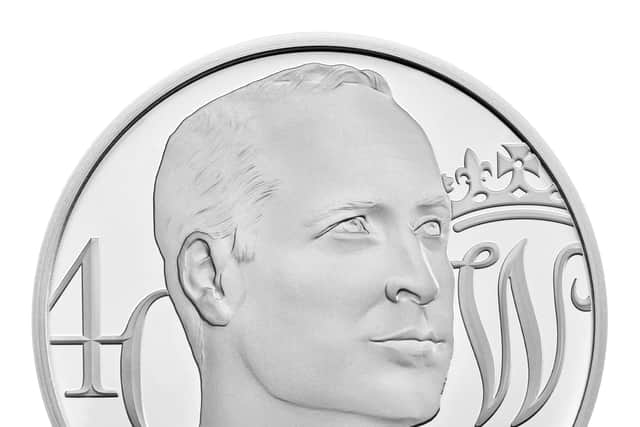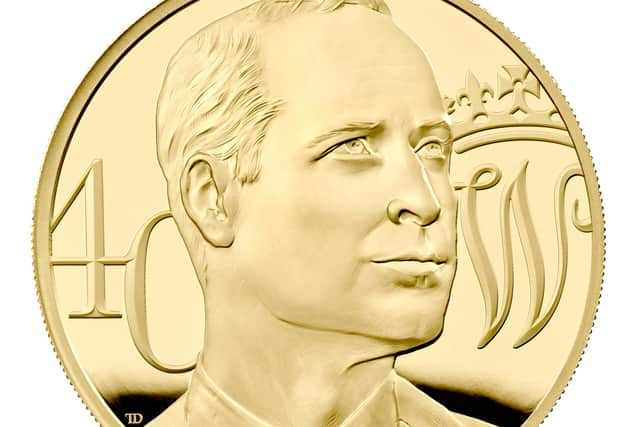Prince William £5 coin: how to get Royal Mint collectable, what does it look like and how old is the Duke?
This article contains affiliate links. We may earn a small commission on items purchased through this article, but that does not affect our editorial judgement.
and live on Freeview channel 276
The Duke of Cambridge will turn 40 later this year, and to celebrate a commemorative £5 coin has been released by the Royal Mint.
The coin is the first time Prince William, who is second in line to the throne, will appear alone on an official coin struck by the Royal Mint.
Advertisement
Hide AdAdvertisement
Hide AdSo, just what does the coin look like, and how can you get one?
Here’s what you need to know.
How old is Prince William and when was he born?
Prince William was born on 21 June 1982, which means he is now 39 years old but will turn 40 later this summer.
His parents are Prince Charles and the late Diana, Princess of Wales.
His grandparents are Queen Elizabeth II and the late Prince Phllip, Duke of Edinburgh.
Advertisement
Hide AdAdvertisement
Hide AdWhy has the coin been released?
The £5 coin has been released to celebrate the 40th birthday of Prince William, which will take place on 21 June.
Alongside the £5 coin, the Royal Mint has also created a limited-edition 5oz gold coin which is not available now but will be released before the Duke’s birthday.
The last time Prince William appeared on a Royal Mint £5 coin was with his wife Kate Middleton to celebrate their 2011 wedding.
What does the coin look like?
The coin, which has been created by designer and engraver Thomas T Docherty, features a portrait of Prince William.
Advertisement
Hide AdAdvertisement
Hide AdIt also has the number 40 and Prince William’s royal cypher, his initial W.
Queen Elizabeth II’s image, designed by Jody Clark, will be struck on the other side of the coin.
There will also be an inscription on the edge reading: ‘HRH The Duke of Cambridge’.


How can I get a coin?
You can buy the £5 coin now on the Royal Mint website.
You can register your interest in the 5oz gold coin now, also on the Royal Mint website.
Advertisement
Hide AdAdvertisement
Hide Ad

What has the designer said about the coin?
The coin’s designer, Thomas T Docherty, said the ‘dynamic portrait’ was created using new digital technology.
He said: “The design strikes a balance between the fresh energy of His Royal Highness being a young dad with the ceremonial nature of his royal position.
“A three-quarter angle of the portrait creates a more dynamic portrait rather than a traditional side-on profile.
“I used certain clay sculpting techniques on a digital platform to achieve the style needed for the design, to translate effectively from two to three dimensions.
Advertisement
Hide AdAdvertisement
Hide Ad“Using technology, we can now produce designs and sculptures with better efficiency compared to when I began my career 17 years ago.
“There’s a high level of skills and craftsmanship needed to sculpt designs - the tools are different but the principles remain the same.”
What has the Royal Mint said about the coin?
The Royal Mint said they have created the coin to celebrate Prince William’s grace.
Clare Maclennan, director of commemorative coin at the Royal Mint, said: ‘The elegant design features a portrait of HRH alongside his royal cypher and the number 40, which pays homage to the maturity and grace of the prince who has become a senior member of the royal family, a devoted husband and a loving father of three, through the eyes of the world.
Advertisement
Hide AdAdvertisement
Hide Ad“Marking this extra special occasion, we have also struck a limited edition gold coin made with 5oz of fine gold and struck in high relief to elevate the artistry of the design.
‘Our limited edition precious metal coins combine fine craftsmanship and rarity, making them an attractive keepsake for collectors and investors.”
Who is Prince William’s wife and who are his children?
In April 2011, Prince William married Kate Middleton, whom he met while they were both studying at the University of St Andrews in Scotland in September 2001.
Together, they became the Duke and Duchess of Cambridge.
The couple have two children, Prince George of Cambridge, age 8, Princess Charlotte of Cambridge, age 7, and Prince Louis of Cambridge, age 4.
Can the coin be used as legal tender?
Commemorative coins are intended to be kept as souvenirs.
Advertisement
Hide AdAdvertisement
Hide AdSilver UK coins produced in denominations of £5, £20, £50 and £100 are approved as legal tender, according to the Royal Mint, but as they have been designed as limited edition collectables or gifts they are not entered into general circulation.
As a result, UK shops and banks are unlikely to accept them if you attempt to use them in a translation.
Comment Guidelines
National World encourages reader discussion on our stories. User feedback, insights and back-and-forth exchanges add a rich layer of context to reporting. Please review our Community Guidelines before commenting.
